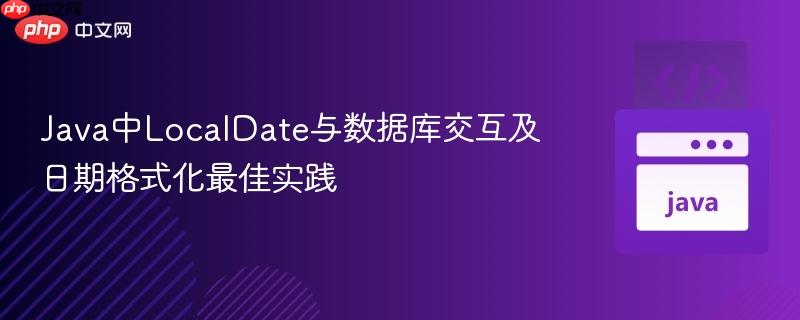
本文旨在解决java开发中关于`Java.sql.date.valueof(java.time.localdate)`方法使用上的困惑,并提供`java.time.localdate`与数据库交互的现代方法,以及如何对`localdate`进行灵活的格式化。文章强调应避免使用过时的`java.sql.date`,转而采用功能更强大、设计更合理的`java.time`包,以提升代码的健壮性和可维护性。
1. java.sql.Date.valueOf(java.time.LocalDate)方法解析
在Java 8及更高版本中,java.sql.Date类已添加了valueOf(java.time.LocalDate)静态方法,旨在方便地将java.time.LocalDate对象转换为java.sql.Date对象。因此,以下代码在正常情况下是完全有效的:
import java.time.LocalDate; import java.sql.Date; public class DateConversionExample { public static void main(String[] args) { LocalDate releaseDate = LocalDate.of(2023, 1, 23); Date sqlDate = Date.valueOf(releaseDate); // 这行代码在Java 8+应正常工作 System.out.println("LocalDate: " + releaseDate); System.out.println("java.sql.Date: " + sqlDate); } }
如果您在执行上述代码时遇到’valueOf(java.lang.String)’ in ‘java.sql.Date’ cannot be applied to ‘(java.time.LocalDate)’之类的错误,这通常不是因为代码逻辑本身有问题,而更可能是开发环境(如ide)出现了缓存混乱或配置错误。在这种情况下,建议尝试以下步骤:
- 重启IDE和计算机:这是解决许多临时性IDE问题的最简单方法。
- 清理并重建项目:在IDE中执行“Clean Project”和“Rebuild Project”操作,清除旧的编译产物并重新编译。
- 清除IDE缓存:许多IDE(如IntelliJ idea、eclipse)都有清除缓存的选项,这可以解决一些深层次的IDE内部状态问题。
2. 现代Java日期与数据库交互
尽管java.sql.Date.valueOf(LocalDate)方法存在,但在现代Java应用中,我们强烈建议避免直接使用java.sql.Date、java.sql.Time和java.sql.timestamp等旧版JDBC日期时间API。这些类存在设计缺陷,例如java.sql.Date虽然声称是日期,但实际上包含了时间信息,且其行为与时区处理复杂。
自JDBC 4.2规范以来,JDBC驱动程序被要求直接支持java.time包中的日期时间类型。这意味着您可以直接将LocalDate、LocalTime、LocalDateTime等对象传递给数据库,并从数据库中检索它们,而无需进行中间转换。
立即学习“Java免费学习笔记(深入)”;
2.1 将LocalDate写入数据库
当使用PreparedStatement时,可以直接使用setObject()方法来设置LocalDate类型的参数:
import java.sql.Connection; import java.sql.PreparedStatement; import java.sql.SQLException; import java.time.LocalDate; public class DatabaseWriteExample { public void insertReleaseDate(Connection connection, LocalDate releaseDate) throws SQLException { String sql = "INSERT INTO my_table (release_date) VALUES (?)"; try (PreparedStatement statement = connection.prepareStatement(sql)) { statement.setObject(1, releaseDate); // 直接设置LocalDate对象 statement.executeUpdate(); System.out.println("Release date inserted successfully."); } } }
2.2 从数据库读取LocalDate
同样,从ResultSet中读取日期时,可以直接使用getObject()方法并指定目标类型为LocalDate.class:
import java.sql.Connection; import java.sql.PreparedStatement; import java.sql.ResultSet; import java.sql.SQLException; import java.time.LocalDate; public class DatabaseReadExample { public LocalDate getReleaseDate(Connection connection, int id) throws SQLException { String sql = "SELECT release_date FROM my_table WHERE id = ?"; try (PreparedStatement statement = connection.prepareStatement(sql)) { statement.setInt(1, id); try (ResultSet resultSet = statement.executeQuery()) { if (resultSet.next()) { return resultSet.getObject("release_date", LocalDate.class); // 直接获取LocalDate对象 } } } return null; } }
2.3 最佳实践与注意事项
- 优先使用java.time:始终优先使用java.time包中的类(如LocalDate、LocalDateTime、ZonedDateTime)来处理日期和时间。它们设计更合理,功能更强大,且线程安全。
- 避免字符串存储:切勿将日期时间值存储为数据库中的字符串类型。这会导致排序、查询、计算等操作的复杂性增加,并可能引入格式转换错误。数据库应使用其原生日期时间类型(如DATE, TIMESTAMP)。
- 转换旧API对象:如果您的代码库中仍然存在java.sql.Date或java.util.Date对象,应尽快将其转换为java.time对象。例如,java.sql.Date可以通过toLocalDate()方法转换为LocalDate:
java.sql.Date legacySqlDate = new java.sql.Date(System.currentTimeMillis()); LocalDate modernLocalDate = legacySqlDate.toLocalDate();
- 充分测试:在将java.time与数据库集成到实际项目中时,务必进行全面的测试,以确保数据在写入和读取过程中保持一致性。
3. 格式化LocalDate进行显示
java.time.LocalDate对象本身不包含格式信息。当需要将LocalDate显示给用户时,通常需要将其格式化为特定的字符串。java.time.format.DateTimeFormatter类提供了强大的格式化功能。
3.1 使用自定义模式格式化
如果您需要特定的日期格式(例如,月份缩写”MMM”),可以使用ofPattern()方法定义一个格式化器:
import java.time.LocalDate; import java.time.format.DateTimeFormatter; public class DateFormattingExample { public static void main(String[] args) { LocalDate date = LocalDate.of(2023, 10, 27); // 格式化为 "27 Oct 2023" DateTimeFormatter customFormatter = DateTimeFormatter.ofPattern("dd MMM yyyy"); String formattedDate = date.format(customFormatter); System.out.println("Custom formatted date: " + formattedDate); // 输出: 27 Oct 2023 // 格式化为 "October 27, 2023" DateTimeFormatter anotherCustomFormatter = DateTimeFormatter.ofPattern("MMMM dd, yyyy"); String anotherFormattedDate = date.format(anotherCustomFormatter); System.out.println("Another custom formatted date: " + anotherFormattedDate); // 输出: October 27, 2023 } }
常用的模式字母包括:
- y: 年份
- M: 月份 (M: 1, MM: 01, MMM: Jan, MMMM: January)
- d: 月份中的天 (d: 1, dd: 01)
- E: 星期几 (E: Mon, EEEE: Monday)
3.2 使用本地化格式化
为了更好地支持国际化,DateTimeFormatter还提供了基于Locale的本地化格式化功能。这样可以根据用户的语言和文化习惯自动选择合适的日期格式。
import java.time.LocalDate; import java.time.format.DateTimeFormatter; import java.time.format.FormatStyle; import java.util.Locale; public class LocalizedDateFormattingExample { public static void main(String[] args) { LocalDate date = LocalDate.of(2023, 10, 27); // 针对英国地区的长格式日期 Locale ukLocale = Locale.UK; DateTimeFormatter ukFormatter = DateTimeFormatter .ofLocalizedDate(FormatStyle.LONG) .withLocale(ukLocale); String ukFormattedDate = date.format(ukFormatter); System.out.println("UK Long Date: " + ukFormattedDate); // 输出示例: 27 October 2023 // 针对美国地区的长格式日期 Locale usLocale = Locale.US; DateTimeFormatter usFormatter = DateTimeFormatter .ofLocalizedDate(FormatStyle.LONG) .withLocale(usLocale); String usFormattedDate = date.format(usFormatter); System.out.println("US Long Date: " + usFormattedDate); // 输出示例: October 27, 2023 // 针对中文地区的中等格式日期 Locale cnLocale = Locale.CHINA; DateTimeFormatter cnFormatter = DateTimeFormatter .ofLocalizedDate(FormatStyle.MEDIUM) .withLocale(cnLocale); String cnFormattedDate = date.format(cnFormatter); System.out.println("CN Medium Date: " + cnFormattedDate); // 输出示例: 2023年10月27日 } }
FormatStyle提供了不同的预定义格式:
- FULL: 最详细的格式
- LONG: 较详细的格式
- MEDIUM: 中等详细的格式
- SHORT: 简短的格式
总结
在现代java开发中,处理日期和时间的最佳实践是全面采用java.time包。它提供了清晰、易用且功能强大的API,能够有效解决旧版API带来的诸多问题。在与数据库交互时,应直接使用java.time对象,并利用DateTimeFormatter进行灵活的日期格式化以满足用户界面的显示需求。通过遵循这些原则,可以显著提升代码的质量和可维护性。


